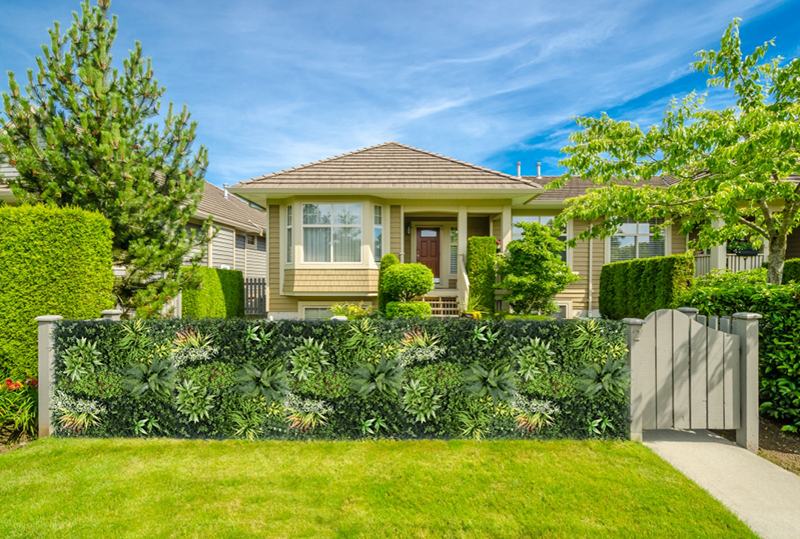Construction plan of large-scale 3D artificial vertical garden
Site survey
Comprehensively assess the lighting conditions, distinguish between full sunlight, semi-shade and full shade areas, and record the changes in daily lighting duration and intensity.
Measure the load-bearing capacity of the building walls or Spaces to ensure that the total weight of the vertical garden (including plants, media, and structures) does not exceed the design load.
Analyze the layout of the existing hydropower system, reserve irrigation pipes and circuit interfaces, and plan drainage paths.
Design plan:
According to the characteristics of the site, determine the geometric shape and spatial layout of the vertical garden, such as spiral, modular or terraced design.
Combining architectural style and functional requirements, the color matching and hierarchical distribution of plants are designed to ensure that both the landscape effect and ecological benefits are taken into account.
Frame installation
The frame is constructed with corrosion-resistant materials (such as aluminum alloy and galvanized steel) to ensure the stability of the structure.
Calibrate the frame with a laser level to ensure it is horizontal and vertical, with an error controlled within ±3mm.
A ventilation gap of 5 to 10cm should be reserved between the frame and the wall to prevent the plant roots from directly contacting the wall and causing mold.
Waterproofing and drainage treatment:
Lay a complete waterproof layer covering the planting area, and seal the joints with special tape to prevent leakage.
Install drainage boards on the waterproof layer and set up drainage outlets to ensure that excess water can be discharged quickly.
Medium filling
Fill the drainage layer with ceramsite or crushed stones in layers, and then cover it with lightweight, water-retaining and breathable planting media (such as a mixture of peat soil, coconut coir and perlite).
Adjust the medium ratio according to the plant type, for example, increase the proportion of particulate matter for succulent plants.
Installation of irrigation and maintenance systems
Layout the drip irrigation pipes and adjust the spacing and the flow rate of the drippers according to the water requirement of the plants.
Install supplementary lighting and ventilation equipment to ensure that plants receive sufficient light and good air circulation.
Plant pretreatment
Prune overly long or rotten root systems and retain healthy main roots and lateral roots.
Before transplanting, place the plants in a cool place to recover for 2 to 3 days to reduce the stress during transplanting.
Planting layout
Adjust the planting spacing according to the crown width of the plants to avoid competing for nutrients in the later stage.
Evergreen plants are used as the base, with colorful leaves or flowering plants dotted among them to form a visual focal point.
Initial maintenance:
Cover with shade nets for the first two weeks after transplanting and spray water 2 to 3 times a day to maintain humidity.
Avoid using chemical fertilizers within one month after transplanting. Instead, spray diluted foliar fertilizer.
Regular inspection
Check every quarter whether the frame connectors are loose, whether the waterproof layer is damaged and whether the drainage outlet is blocked.
Observe the color of plant leaves and the situation of pests and diseases every month, and prune dead branches and leaves or replace dead plants in time.
Pest and disease control
Before planting, the medium is subjected to high-temperature disinfection to reduce insect eggs and pathogens.
Hang yellow and blue boards to trap pests and release predators such as mites and ladybugs to control pests.
Response to extreme weather
Increase the irrigation frequency in summer and lay moisture-retaining MATS or cover the plants with pine needles around them.
Reinforce the frame in advance, prune overly dense branches and leaves to reduce wind resistance, and clear the debris at the drainage outlets in a timely manner after heavy rain.
Intelligent irrigation system
Introduce sensors to monitor soil moisture and light intensity to achieve automated irrigation and supplementary lighting.
Ecological cycle design
Collect rainwater for irrigation and utilize the photosynthesis of plants to improve the local microclimate.
Modular design
Detachable planting units are adopted, which is convenient for plant replacement and system maintenance in the later stage.

Contact: Amy
Phone: 86-15311787313
E-mail: info@foszmac.com
Whatsapp:86-15311787313
Add: Fengtai District, Dacheng Road, No.24 Building, Room 203, Beijing, China